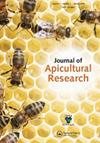Midgut health of Apis mellifera workers on oral administration of Lactobacillus rhamnosus and organic acids
IF 1.8
4区 农林科学
Q2 ENTOMOLOGY
引用次数: 0
Abstract
AbstractA study about the provision of Lactobacillus rhamnosus NR_113332) and organic acids was carried out. 108 colony-forming units of probiotics were provided to the caged workers with and without the addition of 2.99% lactic acid, 2.91% acetic acid, and 1.96% acetic acid. After two weeks of oral administration, on termination, five bees were collected and dissected from each cage, and their midguts were cut into 8 μm thick sections by microtome. Subsequently, these histologically processed preparations were observed under camera fitted microscope. It was observed that the experimental workers were provided with diets: (pollen+ 50% w/v sucrose in 1.96% acetic acid, pollen+ L. rhamnosus in 50% w/v sucrose in distilled water, pollen+ L. rhamnosus in 50% w/v sucrose in 2.99% lactic acid, pollen+ L. rhamnosus in 50% w/v sucrose in 2.91% acetic acid, pollen+ L. rhamnosus in 50% w/v sucrose in 1.96% acetic acid) had a considerable quantity of peritrophic membranes. The mean midgut lumen diameters (µm2) were 373.33 ± 98.38, 296.67 ± 23.33, 243.33 ± 71.72, 426.67 ± 40.55, 576.67 ± 93.87 as compared to control’s 240.00 ± 30.55. The provision of probiotic and organic acids resulted in a slightly disturbed midgut epithelial wall, the presence of more quantity of peritrophic membranes, saved regeneration crypts, more gastric cells discharging, and some cytoplasmic vacuolization of caged worker bees. Our study suggests that probiotics and organic acids can be used as an environmentally friendly apipromotor, but verification by field studies is needed.Keywords: Probioticsorganic acidsmidgutApis melliferaHistological changes AcknowledgmentsThe role of Dr. Sohail Ahmed, lecturer, department of poultry science, University of Veterinary and animal sciences Lahore is much appreciable for assisting in statistical analyses.Disclosure statementThe authors declare that they have no competing interests.口服鼠李糖乳杆菌和有机酸对蜜蜂工蜂中肠健康的影响
摘要对鼠李糖乳杆菌NR_113332和有机酸的添加进行了研究。在不添加2.99%乳酸、2.91%乙酸和1.96%乙酸的情况下,给笼工提供108个益生菌菌落形成单位。口服给药两周后,终止用药时,从每个笼中取出5只蜜蜂,将其中肠切成8 μm厚的切片。随后,在配备相机的显微镜下观察这些组织学处理的制剂。结果表明:(花粉+ 50% w/v蔗糖在1.96%乙酸中,花粉+鼠李糖在50% w/v蔗糖在蒸馏水中,花粉+鼠李糖在50% w/v蔗糖在2.99%乳酸中,花粉+鼠李糖在50% w/v蔗糖在2.91%乙酸中,花粉+鼠李糖在50% w/v蔗糖在1.96%乙酸中)有相当数量的周营养膜。平均中肠管径(µm2)分别为373.33±98.38、296.67±23.33、243.33±71.72、426.67±40.55、576.67±93.87,对照组为240.00±30.55。提供益生菌和有机酸导致工蜂中肠上皮壁轻微紊乱,周围营养膜数量增加,再生隐窝保存,更多胃细胞排出,以及一些细胞质空泡化。我们的研究表明,益生菌和有机酸可以作为环保的蜜蜂促进剂,但需要实地研究的验证。关键词:益生菌;有机酸;真菌;蜜蜂;组织学变化;致谢拉合尔兽医与动物科学大学家禽科学系讲师Sohail Ahmed博士在统计分析方面的帮助非常值得赞赏。声明作者声明他们之间没有利益冲突。
本文章由计算机程序翻译,如有差异,请以英文原文为准。
求助全文
约1分钟内获得全文
求助全文
来源期刊
CiteScore
4.80
自引率
10.50%
发文量
111
审稿时长
6-12 weeks
期刊介绍:
The Journal of Apicultural Research is a refereed scientific journal dedicated to bringing the best research on bees. The Journal of Apicultural Research publishes original research articles, original theoretical papers, notes, comments and authoritative reviews on scientific aspects of the biology, ecology, natural history, conservation and culture of all types of bee (superfamily Apoidea).

 求助内容:
求助内容: 应助结果提醒方式:
应助结果提醒方式:


